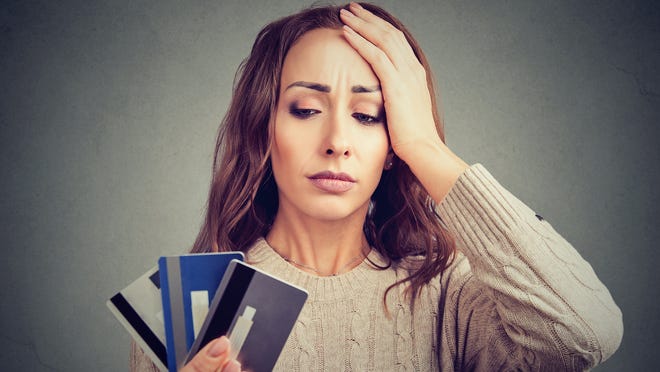
A credit crunch is coming if it isn’t already here.
Some consumers may already be feeling the squeeze of higher interest rates or difficulty getting a loan, and others may soon. The Federal Reserve warned of this last month after the collapse of Silicon Valley Bank. Fed Chair Jerome Powell said upheaval resulting from the banking sector would likely “result in tighter credit conditions for households and businesses, which would in turn affect economic outcomes.”
Despite that, they all still have time to take steps to manage their debt and finances to mitigate the fallout, experts say.
The average interest rate on a credit card has climbed to 20.92%, the highest since the Federal Reserve started tracking this information in 1994. New credit card offers carry even higher rates, averaging 22.15% in the first three months of the year, up from 18.32% at the end of 2022, according to a survey by personal finance site WalletHub.
Additionally, initial credit card bonus rewards are falling, with average cash back down 1.86% in the first three months from the end of 2022 and miles or points down 0.34%, it said.
Learn more: Best credit cards of 2023
Banks are lifting rates, scaling back perks and tightening lending standards to offset their increased risk and minimize loan defaults as recession odds rise and more people lose their jobs. The Congressional Budget Office forecasts the unemployment rate will rise to 5.1% by the end of the year from 3.5% in March. That would equate to about 2.5 million jobs lost.
“Monitoring the credit card landscape can tell you a lot about the health of the U.S. consumer,” WalletHub said. “For example, 0% introductory APRs and initial rewards bonuses dried up during the Great Recession. And the decline in consumer credit quality during that period was a big reason why.”
Recession looms:Are we headed for a recession? More economists think a 2023 downturn may come later than they thought
Cooler spending:Retail sales fell 1% in March, more than expected, as winter spending burst loses steam
How are consumers faring?
Under the weight of inflation and a slowing economy, consumers have so far held up surprisingly well with the help of a strong labor market. However, as rates continue to rise, cracks are showing.
In the final three months of 2022, credit card balances increased by $61 billion to reach $986 billion, surpassing the pre-pandemic high of $927 billion and registering the largest increase since 1999 when the New York Federal Reserve began collecting this data.
More than one-third (35%) of those with credit card debt carry over a balance from month to month, up from 29% last year, according to a Bankrate.com survey in January.
Additionally, credit card borrowers, especially those under 40,, are missing payments and becoming delinquent on payments by more than 90 days faster than they had before the pandemic, the New York Fed said.
“It’s triple trouble for credit card borrowers,” said Ted Rossman, Bankrate.com senior industry analyst. “Balances are up, rates are up and more people are carrying credit card debt.”
Auto loans are also flashing warning signs. The number of loans 60-plus days past due in January was up 20.4% from a year ago and represents 1.89% of all auto loans, the highest share since 2006, Cox Automotive said.
A better rating:What is a good credit rating and why does it matter? How to improve your credit score.
Temporary dip:Student loan forgiveness could ding your credit score. Here’s why.

How can consumers prepare for a credit crunch?
There are some steps you can take now to buffer yourself, including:
- Transfer your balance: “My top tip is to sign up for a 0% balance transfer card,” Rossman said. By transferring your balance to one of these cards, you can “pause the interest clock for up to 21 months.”
- Dump rewards cards: Rewards cards tend to have a higher annual percentage rate than non-rewards cards. “Americans’ favorite credit card feature is cash back, even if they have credit card debt,” Rossman said. “Cash back is great, but only if you’re able to pay your bills in full and avoid interest. It doesn’t make sense to pay 20% in interest just to get 2% in cash back. Put your interest rate first and pursue rewards once you’re debt-free.”
- Improve your credit score: If you think you may need to take a loan at some point, make sure you pay your bills on time each month, take a break from taking on more credit to lower your debt amounts and correct any errors that may be on your credit report. “Building up a good credit score can help keep your interest rate lower,” said Dan Casey, financial planner at Bridgeriver Advisors.
- Build emergency savings: Advisors recommend enough money to cover at least three to six months of living expenses.
- Get a side job: “You might also consider taking on a side hustle, selling stuff you don’t need, or cutting your expenses,” Rossman said. “Every dollar of credit card debt that you pay down represents a guaranteed, tax-free return of whatever your interest rate happens to be.” And on average, that’s more than 20%.
Medora Lee is a money, markets, and personal finance reporter at USA TODAY. You can reach her at [email protected] and subscribe to our free Daily Money newsletter for personal finance tips and business news every Monday through Friday morning.






